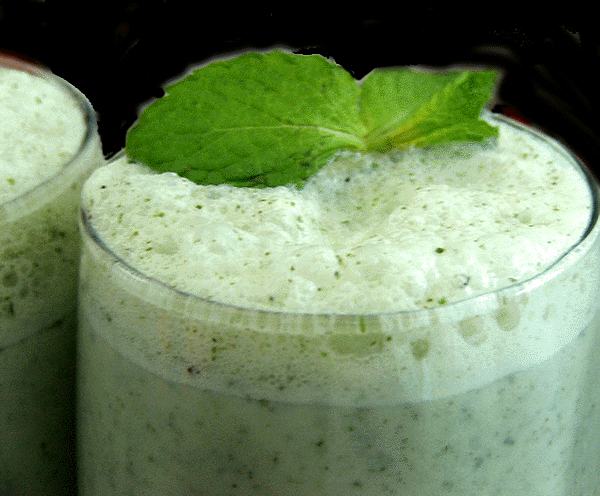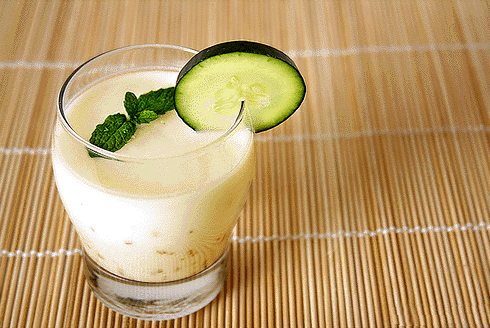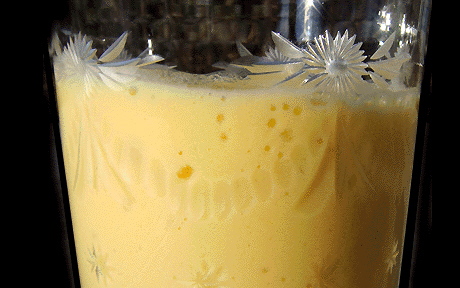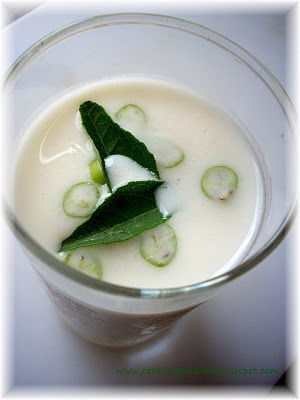
|
|
|
|
BY: SUN STAFF

Minted Salty Lassi Sep 04, 2010 — CANADA (SUN) — A journey through India: border to border, bhoga to prasadam. Buttermilk has been taken as a beverage in India since ancient times, appreciated for its cool freshness and soothing qualities on the digestive system. Vedanta Desika, in his ahara niyama, set down the rules of eating for Sri Vaisnavas. Included under the section of foods to be avoided on ekadasi is the comment that 'foods from which the essence is taken out are forbidden, except buttermilk'. He also states that among the foods that can be accepted without hesitation are 'old rice that is soaked in clean water and taken with buttermilk, ghee, milk, or yogurt'.
Except for the second month of Caturmasa, when it is to be avoided, buttermilk is particularly valued during hot weather. People often take extra chilis to heat the inside of the body, thus making the skin feel cooler against the hot air. Buttermilk is used to soothe the stomach because it coats the digestive tract and absorbs the chili oils, while at the same time stimulating the appetite. Turmeric is often added to buttermilk to increase its use as a digestive aid, and to alleviate stomach discomfort. Aside from its soothing consistency, the fundamental constituents of buttermilk have everything to do with its being so helpful to the digestive system. Like the acidophilus in yoghurt, buttermilk contains helpful bacteria that aid digestion. The lactose sugars in fresh milk tend to slow digestion, but buttermilk's lactic acid converts the sugars, catalyzing the digestive process. Commercial buttermilk is usually low- or non-fat milk to which bacterial culture has been added, but this is a poor replacement for natural buttermilk.

In the Supa-sastra of Mangarasa, composed around 1509 A.D., the second chapter deals with various beverages, including sour, salty and sweet drinks. Many of these are made from buttermilk, sometimes combined with fruit juices. Buttermilk is a prominently featured ingredient in South Indian cooking. In Karnataka, it's an important element in making Idli. Buttermilk idli was also known as iddalika and kadubu in ages past. These idli are made with a paste of fermented rice and black gram combined with buttermilk and spiced with asofoetida, coriander, ginger and pepper, commonly known as masala idli. The preparation of curds and buttermilk was elevated to a culinary art form in Vedic culture. Both curd (yoghurt) and buttermilk were flavored with a variety of things that gave them added taste, color and texture. Today's flavored yoghurts are the modern equivalent. As Adiraja dasa notes in his introduction to Srila Prabhupada's The Higher Taste , buttermilk has an affinity for grains and vegetables, in a way that fresh milk does not. Similarly, buttermilk mixes very nicely with aromatic spices, fruit pulps and fresh berries. These added flavors are held by the butterfat molecules, which absorb and carry the flavors along with the smooth, natural tanginess of the buttermilk. The simplest way to use buttermilk to advantage is naturally as a beverage, and while many are very simple, some buttermilk drinks are quite sophisticated combinations of flavor and texture. All sorts of spices can be comported along with the butterfat, from pungent to aromatic. In fact, buttermilk itself is a combination of three tastes – sweet, sour, and astringent – so it's not surprising that the stuff combines well with many other flavors.

Mango Buttermilk Lassi Lassis are generally made in one of three basic ways: sweet, fruited, or salted. Each has its own short list of best spices. Sweet lassis can be made with most any type of sweetener: honey, jaggery, cane sugar, etc., and aromatic spices are commonly used, like cardamom, cinnamon, and nutmeg. Saffron, vanilla and rosewater are also nice additions. Fresh mints are also delicious. Fruited lassis, like mango, banana or berry, go well with all the aromatics, but are equally wonderful with chaat masalas made from chili pepper, black salt, amchoor (dried mango) and asofoetida. The pungent spices take the edge off the fruit's sweetness, and combine nicely with the tang of buttermilk. Salted lassis can be made with straight buttermilk, or buttermilk thinned with water, and they're generally spiced with salt, cumin, and sometimes coriander, or fresh ginger and chilis ground to a paste. For an even more pungent salty lassi, use roasted cumin powder. Salted lassis are often called 'spicy lassis', and in the south they go by the names pacha moru (spiced salted buttermilk) or kachiya moru (buttermilk spiced with chilies and curry leaves). The spice factor can be ramped up according to taste. There's a popular spiced lassi in Kerala known as Sambaram, which features fresh buttermilk flavored with ginger, green chilis and curry leaves. The ginger and chilis can be mashed to a paste and blended into the Sambaram, and also used as a garnish. Lime juice is also a nice addition to salty lassis, and carbonated water can be added to all types of lassis for an effervescent effect.

Sambaram
| |